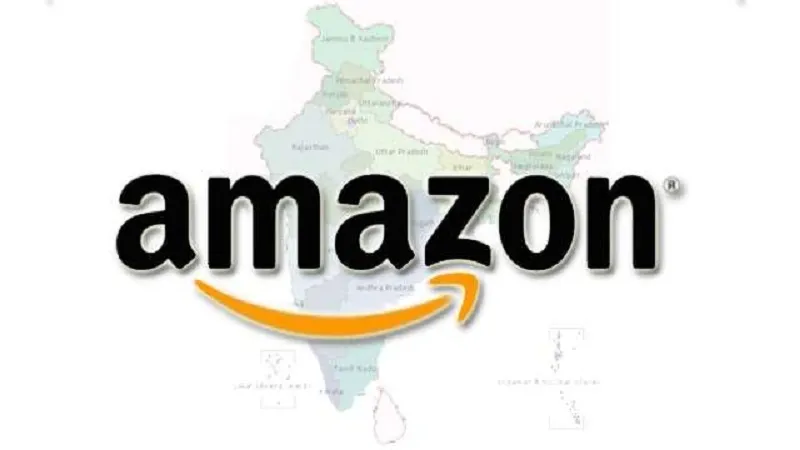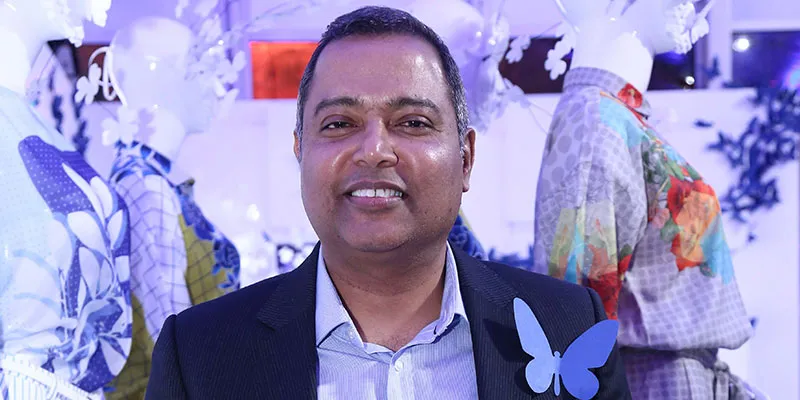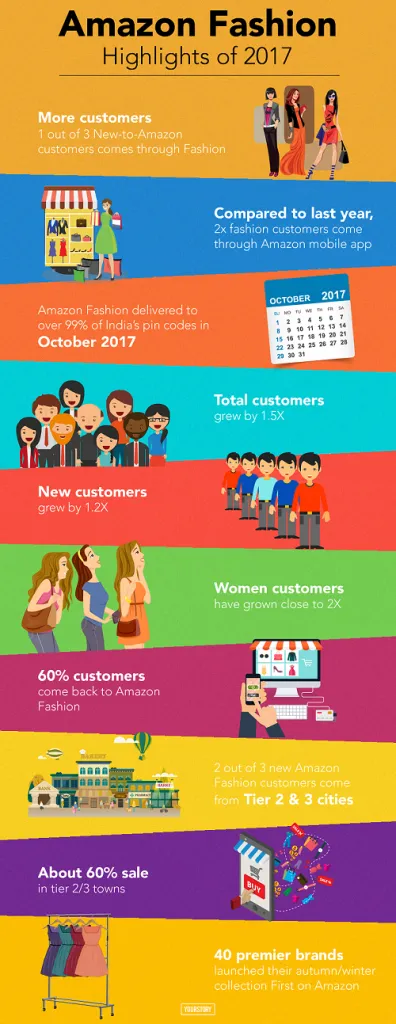Why Amazon Fashion isn’t keen on discount sales like Flipkart or Myntra, and what its plans for 2018 are
Fashion is the largest category in India’s e-commerce market, but Amazon is foregoing sales and opting for newer methods such as partnerships with brands, introducing warehouses, and focusing on Prime.

When US-based e-tail giant Amazon entered India in 2013, the whole world took notice – not only because India was a rising economy, but because India was already witnessing the growth of a new economy.
A bunch of entrepreneurs were bringing in disruption in B2B and consumer internet businesses, led by online marketplace Flipkart, cab aggregator Ola, digital payments platform Paytm, and SaaS biggie Freshworks (then Freshdesk) among others.
But Amazon was bringing in 20 years of first-hand knowledge from its experience in multiple geographies. When a veteran enters with billions in its kitty, it grabs headlines.
Four years later, Amazon’s journey in India has been one of reinventing itself. Firstly, due to the country’s laws regarding online retail, Amazon is following a marketplace-model unlike the retail model elsewhere. In another unique step for India, they provided a cash-on-delivery option as majority of customer base is still not comfortable with online payments.
Over the years, they opened huge warehouses, initiated innovative programmes for their lakh-strong seller-base, and introduced their flagship programme Amazon Prime last year.
But there are a few fundamentals to know about e-commerce. One is that fashion is globally its largest category, which also provides the highest margin. While the Flipkart-Myntra-Jabong alliance claims 70 percent market share in the Indian online fashion market, Amazon has woven its own differentiators in this category. In fact, the past 12 months have been important for Amazon Fashion as they expanded their selection, acquired new customers, and entered partnerships with high-end brands.

In an interaction with YourStory, Arun Sirdeshmukh, Business Head, Amazon Fashion, recollects the internet major’s efforts over 2017, and the reason behind those decisions – like the tie-up with Shoppers’ Stop, introducing warehouses for fashion, and conducting minimal discount-based sales.
“Penetration of fashion (in online retail) is about 15 percent. One of six products bought in the US and Europe is in fashion. But in these countries, e-commerce is 15-20 years old. So customers are more used to it there. In India, the e-commerce journey started only seven years ago, and we entered only four years ago. We are in the 3-4 percent for fashion e-commerce,” he explains.
Amazon has always based its strategy around its famous “three pillars” – largest selection, convenience (fastest delivery), and best price. But Arun is all about details. He tells us what Amazon wants to projects itself as, and how they are doing it.
Expanding the selection
Amazon claims that they closed 2016 as the largest platform for fashion.
“In 2017, we grew 50 percent in selection and added 300 new exclusive brands – including key brands like Mothercare, Marks&Spencer, and Forever21. Exclusives like GAP and brands like Van Heusen are available online only on our platform,” Arun says.
He claims that Amazon not only carries the flagship for the brand online, but also provides their largest and exclusive collection – like Swarovski’s Confluence collection and Arrow’s Smart shirt collection.
Amazon added 50 percent new selection in 2017. Through the “first on Amazon” programme, 50 brands launch their new collection first on Amazon, even before their physical stores. The list is set to expand.
Amazon also introduced the Seller Flex programme this year through which Amazon can link inventory that is not in their fulfilment centre.
Arun explains, “The inventory might be lying with the brand, or with the seller. But that inventory goes live as though we are carrying it. We have launched 300 FCs for fashion. For instance, Madura Garments (as a distributor) gives their inventory to our preferred partner Cloudtail. But Madura has a wider selection. So, we have linked their warehouse and have a wider selection for the customer. For fashion category, this initiative is important since we have a wide selection.”
This service is now available in Mumbai, Bangalore, and Delhi.
A few months ago, Amazon entered a partnership with Shoppers’ Stop, which gives them exclusive access to SS’ private labels and exclusive brands. In fact, Amazon has already launched 150 of SS’s exclusive labels such as Haute Curry, Kashish, Sanaa, and Rheson. This tie-up also gives Amazon connection to more geographies.

(picture courtesy: Vogue.in)
Arun explains, “Now we are connecting through Seller Flex into their fulfilment centres. Our ramp-up in the East has been slower. The East has not been an open market for us, but now with the SS tie-up, their FCs carry the best of brands on our platform. So that inventory is available for Next-Day delivery.”
Amazon has not onboarded all SS brands yet, as they have to connect with their FCs. They also plan to collaborate with them in marketing.
Laying the ground work with Prime and FBA
Amazon has 45 fulfilment centres across the country. In fact, they have doubled capacity to carry the inventory in those FCs since the festive season last year.
For fashion category on Amazon, there are two tags: FBA (Fulfilment By Amazon) and Prime, their subscription programme which was launched last year.
Arun claims that the FBA tag gets the largest business for Amazon, as the customers believe they will get the items on time. (The FBA tag is given only for products which are lying either in Amazon’s FCs or their SF nodes.)
Prime contributes to one-third of Amazon’s deliveries. But its selection is dynamic, depending on the location, as Prime promises delivery in a day or two for its customers.
Arun elaborates, “If X percent of an inventory is Prime, it is a combination of where the seller and the customer are. For a city like Agartala, you will see no Prime tag. Because none of it is deliverable in a day or next day.”
Amazon aims to increase the extent of products under Prime. But it is a complex task. The Prime button shows you only Prime items when a Prime customer switches it on. So for a customer in Delhi, they have to ensure that their preferred selection is in Delhi at the same time.
“Since we have the largest selection in fashion, it is a complex exercise to make good with Prime-enabled selection. Because we have to carry more in places of demand. In metro cities, it will be a significant number. Whenever a customer is browsing, we have a sense of the extent of the inventory that is Prime. So we work up from that through complex logistics and data mining exercises. Thus, Prime is a significant part of our 2017 narrative,” Arun says.
However, it is too early to introduce Prime Wardrobe, Amazon’s experiment for its Prime users in the US, which allows them to try products (in fashion category) before paying. It lets you choose 3 to 15 products to try on; you need to pay only for what you want to keep, and return others in seven days by leaving them in a box outside.
But, as Arun says, it is a complex process with inventory from different FCs coming into one box and then returns going back to all those FCs.
“Prime Wardrobe is in beta stage in the US. We have to get better at Prime, and better at our wardrobe, and wait for data to tell us what works,” he adds.
In India, Flipkart-owned Myntra offers “Try and buy”, although their structure is not as elaborate as Amazon’s.
Customer retention
Fashion is the fastest growing and largest segment for Amazon.
“Customers tend to find it easier to shop for fashion when they come on Amazon for the first time; 60 percent of our fashion shoppers come back and shop with us again at least within 12 months,” Arun says.
According to Arun, a survey that Amazon had commissioned with research firm IMRB – with 32,000 respondents across 200 cities – has found that during the last festive season, the first single largest platform for fashion was Amazon, with 38 percent respondents shopping on Amazon.
“This makes us the largest by order-share platform in online fashion by a great margin. When we compare with multiple sites, we are neck-on-neck as a single platform. For several brands, we are the largest partner. Our vision is to be seen as the single most important, largest platform for fashion,” he adds.
There are 450 million Indian internet users; Amazon has 150 million registered customers. Ideally, do they need new customers or more retention of old customers?

“Gimmicks will tell new customers to come and shop with us because we have a deal; of course, we get new customers with that. But we already are the most visited site for e-commerce in India. One out of three users who come on Amazon check out fashion products. We would rather make existing customers shop more products, more often,” Arun says.
Customer acquisition
Amazon is tactful in its customer acquisition.
Arun explains, “We are clear about what we are/want to be seen as. There are businesses that tend to be a lot more promotion-oriented. Customers go to them because of deals. But Amazon wants to be your longer-term partner.”
Although its rivals Flipkart, Myntra, and Jabong, has grand discount sale events almost every month, Amazon's strategies are different. After all, e-commerce has to lure customers from offline shopping first. Amazon wants customers to come to them instead of going to a physical shop – even without discount sales.
“If discount sale is the only reason for you to come to the platform; it will also be an easy reason for you to stop coming to the platform. We want you to come because we carry the best and widest selection, provide it you quickly, and allow easy returns. We are doing many other things to understand what makes you shop more. Personalisation is one of them,” he says.
However, he does not deny that discount sales-events are important sometimes. Yet, Amazon has had only a few events this year, compared to its competitors – the Amazon Great Indian festival and Wardrobe Refresh sale.
The point to be noted is that every business has its own cycle. In the mobile phone business, new launches of enhanced versions of models become a good reason for customers to switch and buy. In grocery, there is a bulk purchase typically made at the beginning of the month. But in branded fashion, which is not an everyday purchase, products are more seasonal and fashion oriented.
Arun elaborates, “In fashion, each season lasts about six months. You introduce new products through the summer and towards the end of summer you have to get rid of those. It tends to be more important where there is a weather change. In north India, you cannot but switch your wardrobe during winter as you have to wear layers and wool. In women’s wear too, when a style is trending, you have to be wearing it. We have to clear space and fill it up with the new (pre-ordered) inventory that is beginning to flow into warehouses.”
For Amazon, such events are part of the flywheel.
“We want to get some other fundamental things right. In frequency of purchase and size of business, we have hindsight as a company. We have experience in the US, eight countries in Europe; we know the kind of frequency we can achieve,” Arun says.
Long-term investments
In retrospect, 2017 was the year when Amazon Fashion focused on building the right things for their long-term plan. One among those efforts was Blink studio in Delhi, which was opened in September. Spread over 44,000 sq. ft. with a state-of-the-art digital imaging facility, the studio is first-of-its-kind in India and only third of its kind globally by Amazon, after New York and London. With 16 high-tech photography bays, a large editorial suite, and video editing facilities, the studio enables Amazon Fashion and its partners to produce high quality images for its fashion merchandise.

Arun calls this a long-term investment meant to make Amazon the leader in business – in long term, not in a day or month. They are also working on a plan for an experience centre. Although he did not give a date or location for the centre, he said that it will be meant for pickups, returns, and getting the right size, and not touch-and-feel since their selection is too big for that.
According to Arun, it is a wrong notion that Amazon is all about online shopping.
“We believe that online is probably the most convenient way for you to shop. But, in that journey, if there are touch points that are offline, why not use them? We have launched the smart lock in the US. Udaan is a physical touchpoint. We have significant points for pick up instead of delivery. If the physical presence of any kind helps, we will do it,” he says.
(With 2 out of 3 new customers coming from tier-2 and tier-3 towns, Amazon’s Udaan programme – launched in 2015 – gains more prominence. Udaan provides assisted online shopping for those who have never shopped online before, through a physical kiosk.)
New Year, new plans
Customer experience and Amazon Prime are the most important strategies the company wants to better.
“We understand the customer experience in terms of browsing and looking for the product. That includes the visual aspect too: image quality, editorial content for recommendations like “top five picks in handbags” and “Get the look” – for what accessories go with your outfit etc., providing price breakup for precious jewellery etc.,” Arun says.

Additionally, for visual effect, Amazon will add more features by looking at international sites. Through usability studies they have identified the need to get better with tools and buttons in certain areas – like how to recognise a customer for top brands.
Arun explains, “These are two different journeys: you shop in a mall, next day you are in a premium store. How do we find out if you are looking for a top brand? How can we recognise that your shopping is more brand-oriented and out of the vast selection you see, you have some brands in mind? In such situations, there is lot of work to be done.”
Amazon is yet to build on its private brand too. It is a relatively new journey for them, and they are focusing on quality, customer reviews, lower returns, and expanding the selection. So far, they have private brands only in apparel and footwear for men.
“We want to ensure that there is good repeat and customer acceptance – it is still a young journey. In 2018, we want to add more segments, and expand the selections for top brands,” he concludes.
Amazon’s rivals in India are focused on profitability now. While Flipkart claims majority market share in fashion as well as mobile phones and electronics, the fact remains that online fashion offers vast opportunities.
A recent report by Facebook and BCG (Boston Consulting Group) has said that from the current 4 percent share in market, online fashion will grow to 11-12 percent by 2020. It also states that online fashion in India will be worth $30 billion by 2020, and that 2 out of 3 apparels sold will be branded ones (currently it is less than $7 billion).
Amazon is aggressive in taking a bite out of this pie. As its founder Jeff Bezos says, for Amazon it is always Day 1. The coming year is sure to see more innovations in e-commerce from the veteran and its rivals.







